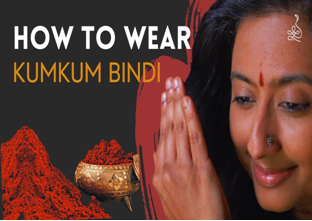KUMKUM
FROM SAMPATH’S DESK:
KUMKUM
(VERMILLION – குங்குமம் - कुमकुम )
(Tilak,
Bindhi, Teeka)
Kumkum
(Vermillion) is a slaked-lime mixed powder of dried turmeric/saffron, carrying
earthly and salubrious properties, applied in the middle of one’s forehead, mostly
by Indian/Hindu women as their unique age-old tradition and custom, both as a
religious mark as well as a facelift. It’s also called ‘Bindhi’, ‘Tilak’, ‘Sindoor’,
‘Sindura’, and ‘Teeka’, generally believed to represent power (Shakti). Red Kumkum
is the norm although it comes in different other colours as well.
After
taking bath, I daily apply red kumkum (from the collection of the Holy Kumkum Prasad
we have at home) on my forehead and experience my body and mind bubbling
and brimming with positive energy. Our elders used to decry and belittle a bare
forehead as a ‘desert’ bereft of propitiousness. Such a mark on the forehead is
considered good omen, auspicious, and fortune-getter.
Kumkum
is offered to God while worshipping and performing Poojas. Kumkum is worn by
males also. Kumkum already offered to God during Poojas is given to devotees as
‘Prasad’ (பிரசாதம்) which is reverently taken
and applied by all on the forehead.
As everyone knows, red is the king of colours symbolizing love, energy, strength, heat, activity, attractiveness, and passion, among others. Red is also associated with sacrifice, danger, robust course change, courage, forewarner, etc. The red version is applied as a face decoration, especially by women. Red kumkum is the most preferred one not only for good outlook but also to reap supposed beneficial effects. Red kumkum/bindhi is believed to keep evil forces away. Red Kumkum applied on the forehead produces and begets positive physical and mental energies with its optimistic and promising vibes, loading the heart with pleasantness and the mind with a feel-good factor, keeping negative energies and spirits at bay.
In
the modern world, Kumkum comes in different colours. Now, the trend with
Indian/Hindu women is to sport ‘sticker bindis’ on the forehead in a place
which they consider in tune with the current/latest fashion.
Married Hindu women
apply red Kumkum (Senthoor or Sinthoor) in the parting of their hair conveying
the message that they are married, although some skip this practice nowadays.
On the forehead, between the two eyebrows, is the spot that has been considered a major nerve point in the human body since ancient times. The Tilak
is believed to prevent the loss of ‘energy’. While applying kumkum on the
mid-brow spot, Adnya-chakra (supposed ‘third eye’) is automatically pressed and
activated. This facilitates the blood supply to the facial muscles.
Once,
black-coloured paste/plaster (சாந்து) was used for a long time. ‘Kaala Teeka’ (‘Kaajal’ – Kohl - applied on the cheek or behind
the neck) is believed to keep away or drive away the ‘evil eye’ and
give positive vibrations/energy. Ajna (अजना ) – located on the forehead between the eyebrows and
considered part of the PRANIC system is the chakra of intuition,
self-realization, inspiration and imagination.
And, whenever you touch any part of your forehead, especially the spot between
the two eyebrows, positive energy from this chakra allows you to see and
understand the inner and outer worlds and generates wisdom.
Some people, mostly men, sport different, coloured and
designed religious marks on their foreheads. And, most girls/young women
nowadays opt for different coloured and designed Bindhis and use their smallest
versions and stick them in just above or in between the eyebrows.
Kumkum/forehead marks seem to separate generations. While older female generations wore and are wearing mostly big round-shaped red kumkum stickers
applied right at the centre of the forehead, the girls and modern women prefer
the smallest-shaped stickers matching their dress colour applied right in
between the two eyebrows. In cinemas and TV serials, one can conspicuously see
the difference. While older characters (like mother, mother-in-law, aunt, etc)
are seen with a bigger kumkum posted at the centre of the forehead, modern
girls wore just much-truncated dot-like kumkum stickers of any colour, shape
or design applied in between the two eyebrows. And, an onlooker may find it difficult
to locate it.
(R.SAMPATH)
4/1/2024







Comments
Post a Comment